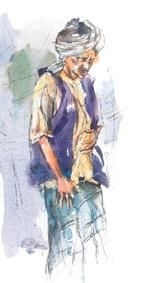Article
Seeking the diagnosis, I stumbled on the cure
Author(s):
A patient encounter that happened 30 years ago is still teaching the author about medicine.
Seeking the diagnosis, I stumbled on the cure
A patient encounter that happened 30 years ago is stillteaching the author about medicine.
By M.P. Ravindra Nathan, MD/ Cardiologist/Brooksville, FL

It was a typically grueling session at the outpatient clinic in my homestate of Kerala, India. This was my first job after finishing my postgraduatework in 1969, and I was eager to give the locals who visited this largegovernment hospital the benefit of my British training.
By 8 am, a crowd of patients was already waiting. On days like this,my resident and I would generally see almost 300 patients in five hours.We'd ask about the chief complaint and do a cursory exam while the patientremained standing. At best, we could only prescribe some stock medicineor an antibiotic from the hospital dispensary. Mercifully, many of the patients'problems were mild, so they didn't require hospitalization. But enough neglectedand chronically ill patients came to boost the 200-bed hospital's censusto more than 300.
When Mr. Jamal arrived--surrounded by his wife, three wailing children,and several friends from his village--I could tell that he was one of theseriously ill. His face contorted with pain, he said he'd been experiencingabdominal discomfort, weight loss, and fever for a month. But he had nocough, diarrhea, or bloody stools. And, because of his Islamic faith, Iwas sure his problems weren't related to alcohol.
Why hadn't he sought help earlier? "Sahib," he told me, "ifI don't work one day, my beebi and three kids will go to bed hungry."He spoke haltingly, clearly divulging something he'd rather have kept tohimself.
Mr. Jamal's comment didn't surprise me. His dirty garments and ragtagturban declared his abject poverty. Daily wage laborers like him earnedlow incomes and simply worked until they dropped dead. Many regarded hospitalizationas just one step before the grave, and therefore something they should avoid.Often, friends or neighbors who entered the hospital were carried out incoffins.
Mrs. Jamal's eyes, welling with tears, seemed to plead with me: "Don'tlet him die. Do something." I fervently hoped that I could,for the family's sake.
Mr. Jamal looked tired and chronically ill. Dehydration had accentuatedthe lines on his face, making him appear older than his 45 years. He wasfrightened, too; his dark, deeply set eyes watched me carefully, and hebarely responded to my questions.
I could feel a few small lymph nodes in Mr. Jamal's neck and axillae,but they didn't seem particularly menacing. He had bad teeth, the resultof chewing tobacco; this was a common problem in an area where there wereno dentists to undo the damage.
There was significant hepatomegaly, but no splenomegaly or ascites. Achest X-ray revealed a little hilar prominence, but no TB or cancer. CBCshowed mild anemia with no abnormal cells. The few hookworm ova in his stoolsample were common for India's barefoot laborers. There were no amebic parasites.The limited liver function tests we could do in those days were unrevealing,and CT and ultrasound technology didn't exist yet.
I pondered the differential diagnosis. Mr. Jamal clearly didn't havepulmonary tuberculosis, the scourge that had taken the lives of thousandsof undernourished Indians. Nor did he have a malignancy of the lung or anyform of leukemia. Nonalcoholic cirrhosis was a possibility, especially withhis poor nutritional status and enlarged liver. Hodgkin's disease and otherlymphomas were strong considerations, too, since they were quite common.But the most likely possibility, I thought, was carcinoma of the liver.
Suddenly, my heart ached. The diagnosis of a cancer or lymphoma wouldbe an immediate death sentence for Mr. Jamal. Our government clinic hadno facilities for chemotherapy or radiation, and my patient couldn't afforda private cancer center. If he were to die, his entire family would surelystarve.
Mr. Jamal needed an urgent workup. A lymph node biopsy might give mean answer, but the busy surgeon wouldn't get to it for a day or two. I knewthat with cancer or lymphoma, the pathology was in that enlarged liver.However, liver biopsies were rarely performed in India's community hospitalsin those days, because of the possible complications and the lack of adequateblood supply for transfusions. Despite these drawbacks, I decided to doa liver biopsy with a Menghini needle the following day.
With cringing submissiveness, Mr. Jamal stoically tolerated the needle'sassault. I prayed that the Lord would keep my inexperienced, trembling handssteady. I worried not about my reputation, but about my conscience. Aboveall, I wanted to help Mr. Jamal cheat his apparent rendezvous with death.
As I pulled back the syringe's plunger, there was a spurt of chocolate-brownliquid. "Anchovy sauce!" I heard myself exclaim, recalling themetaphor from medical school. My needle had penetrated an abscess cavity,yielding the pus typical of amebic liver abscess. After the abscess drained,I administered a course of emetine and chloroquine, the best drugs thenavailable.
Mr. Jamal made a complete recovery.
Just as my professors had stressed in medical school, I've learned thatmost often, we encounter the common diseases in clinical practice--evenwhen the presentation is unusual. Amebiasis is endemic in south India, and,left untreated, it can lead to amebic hepatitis and liver abscess, well-recognizedcomplications. I'd been thrown off track by Mr. Jamal's lack of typicalcolonic symptoms and by the paucity of ameba in his stool sample. But serendipitously,perhaps because of my headstrong desire to help, I'd given Mr. Jamal theright treatment.
When Mrs. Jamal came to pick up her husband, her three scrawny, shy,but curious kids clinging to her sari, I saw tears of gratitude in her eyes.They seemed to be telling me: "You did do something for my husband!"Pondering my incredible luck, I became misty-eyed, too. When I'd first mether, I had groped for words to comfort her and wondered how I could justifyher faith in me. Now I was relieved that I'd been able to help, and thatMr. Jamal would still be around to support his family.
I knew then that my training in medicine would never end. Nor would theresponsibility to alleviate suffering among the most neglected people. Tothis day, I still treat them at no charge in my practice, and often fondlyremember Mr. Jamal.
M.P. Ravindra Nathan. Seeking the diagnosis, I stumbled on the cure. Medical Economics 1999;19:152.





